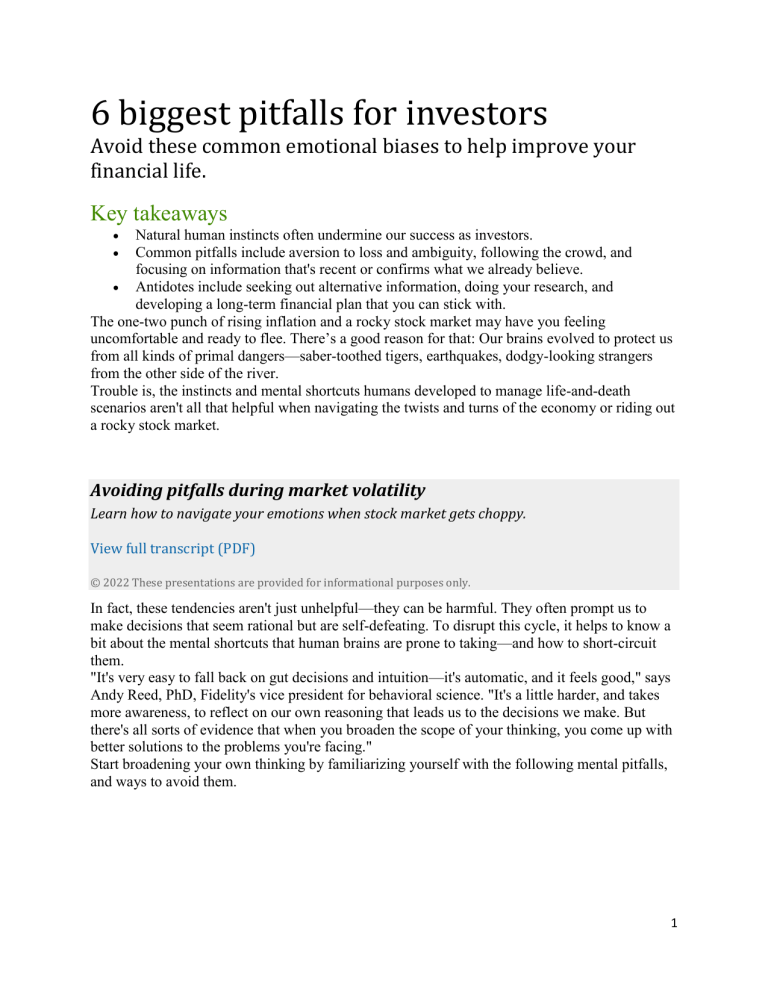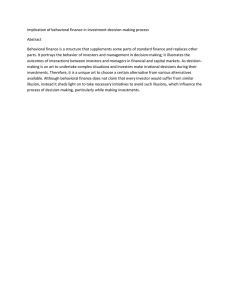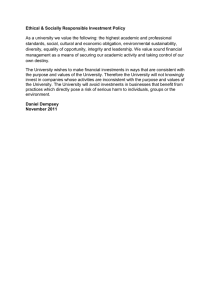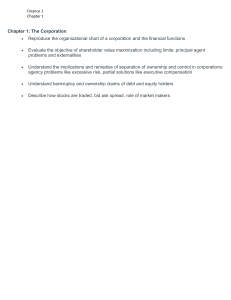
6 biggest pitfalls for investors Avoid these common emotional biases to help improve your financial life. Key takeaways Natural human instincts often undermine our success as investors. Common pitfalls include aversion to loss and ambiguity, following the crowd, and focusing on information that's recent or confirms what we already believe. Antidotes include seeking out alternative information, doing your research, and developing a long-term financial plan that you can stick with. The one-two punch of rising inflation and a rocky stock market may have you feeling uncomfortable and ready to flee. There’s a good reason for that: Our brains evolved to protect us from all kinds of primal dangers—saber-toothed tigers, earthquakes, dodgy-looking strangers from the other side of the river. Trouble is, the instincts and mental shortcuts humans developed to manage life-and-death scenarios aren't all that helpful when navigating the twists and turns of the economy or riding out a rocky stock market. 0:00 / 9:42 Menu Avoiding pitfalls during market volatility Learn how to navigate your emotions when stock market gets choppy. View full transcript (PDF) © 2022 These presentations are provided for informational purposes only. In fact, these tendencies aren't just unhelpful—they can be harmful. They often prompt us to make decisions that seem rational but are self-defeating. To disrupt this cycle, it helps to know a bit about the mental shortcuts that human brains are prone to taking—and how to short-circuit them. "It's very easy to fall back on gut decisions and intuition—it's automatic, and it feels good," says Andy Reed, PhD, Fidelity's vice president for behavioral science. "It's a little harder, and takes more awareness, to reflect on our own reasoning that leads us to the decisions we make. But there's all sorts of evidence that when you broaden the scope of your thinking, you come up with better solutions to the problems you're facing." Start broadening your own thinking by familiarizing yourself with the following mental pitfalls, and ways to avoid them. 1 1. Avoid losses at all costs: Loss aversion What it is: The fear of loss is a stronger motivator than the pleasure of gain. As a result, people tend to avoid the risk of losing money, even if that means not reaching their goals. How it plays out: Fear of loss can cause investors to invest too conservatively, and overreact during market volatility, selling low. The problem: If you only invest in low-risk, low-return investments, your money may not grow enough to reach long-term goals like retirement. And selling out of fear during market downturns locks in losses, making it harder to catch up. How to prevent it: Planning helps you focus on long-term goals, not short-term fears. If your goal is 20 years away, a loss over one month or year probably isn't all that important. Focus on your individual goals and time horizon. And monitor your investments and progress toward your goals on a set, not-too-frequent schedule—perhaps once or twice a year, or if your goals or situation change. 2."I am the greatest!" Confirmation bias What it is: We tend to seek out information that confirms or supports what we already think, and reject information that doesn't. In the words of Muhammad Ali, "I don't always know what I'm talking about, but I know I'm right." How it plays out: Say you've just invested in a company's stock. As you continue reading up on the firm, you come across 10 positive headlines and 10 negative ones—and click only on the ones that support your decision. The problem: Limiting yourself to information that confirms what you already think can cause you to miss important warning signs. How to prevent it: Repeatedly ask yourself: "What could I have gotten wrong?" Seek out information from a diverse range of sources. A good place to start is Fidelity's stock, bond, ETF, and mutual fund research pages. 3. Getting stuck on the first thing you see: Anchoring bias What it is: We tend to latch onto the information we receive first—whether it's relevant to the decision we're making or not. How it plays out: We commonly anchor on specific numbers just because, well, we know about them. Imagine your friend is raving about a mutual fund you've never heard of that she just bought at $50. But by the time you check the quote it's already at $55. So you decide not to pursue the idea. The problem: The anchors our brains pick often have zero bearing on the decision to be made. For example, whether it makes sense to buy a fund at a given price depends on factors such as your situation, the fund's strategy, and future prospects. The price your friend bought at is completely irrelevant. How to prevent it: Ignore the anchor. Do your homework. For stocks and stock funds, consider investment fundamentals like earnings growth, price-earnings ratio, and free cash flow. For bonds and bond funds, research factors like the issuing company's strength and credit rating as 2 well as interest rates. Also consider how these investments would fit into your overall financial plan. And if you can't do it yourself, get help from a professional. 4. The breaking news problem: Recency bias What it is: We tend to over-emphasize information we just received, because it's most readily available to our brains. How it plays out: When the market is down, we tend to feel—and sometimes act—like it's going to keep falling forever. And when the market is rising, we tend to feel and act like it will never stop. The problem: Recency bias can lead you to invest more at market tops and sell at market bottoms—just the opposite of what successful investors do. Add to that a 24-hour news cycle that bombards us with breaking news, and there is no shortage of stimuli to point us in the wrong direction as investors. How to prevent it: Stop constantly checking on what the market is doing. Most scary headlines have little impact on long-term market trends. Focus on your personal goals. Consider building a mix of stocks, bonds, and short-term investments to get there. If market moves shift your asset allocation—or your situation or goals change—think about how you can rebalance back to your target mix. That discipline can help you buy low, sell high, and build wealth over time. 5. There's safety in numbers ... right? Herding bias What it is: We humans tend to follow the crowd, saving time and mental energy by doing what people around us do. How it plays out: Multiple people in your life start talking about a particular investment. You figure if it's that popular, it must be worth buying. The problem: The crowd is often wrong. When it is, the repercussions can be costly: Think internet stocks in 2001. How to prevent it: Rather than following the crowd, focus on developing an investment plan that's right for you. That means a plan that takes into account your individual goals, situation, and time horizon—and one that's diversified. Diversification doesn't mean you won't ever lose money. But owning a mix of investments can help reduce the risk. That way if some investments drop, others may rise, helping you reach your goals. 6. The devil you know: Ambiguity aversion What it is: People tend to be more comfortable with things that are predictable and shy away from uncertainty. How it plays out: You might be tempted to load up on investments that offer predictable returns—like money market funds or bonds with a fixed rate of return, versus a growth stock with no dividend and uncertain returns. The problem: Sometimes sticking to your comfort zone is risky. For example, if your goal is to grow your money over a long time period, investments with predictable returns might not give you the best chance to achieve your goals. 3 How to prevent it: Establish a financial plan centered on your goals and situation. Build an investment mix that can include stocks, bonds, and cash to help achieve those goals in your chosen time frame. And then stick to it. The bottom line Understanding the mental shortcuts we're primed to take is the first step in combating their influence on our decision-making. That task is made easier by developing—and sticking to—a solid financial plan that's squarely focused on achieving your individual goals. In times of uncertainty, that plan can remind you of your priorities and help you build the resources you need to reach your goals. A good place to start is the Planning & Guidance Center on Fidelity.com where you can set goals and begin building a plan. Need help? Consider working with a professional. 4







